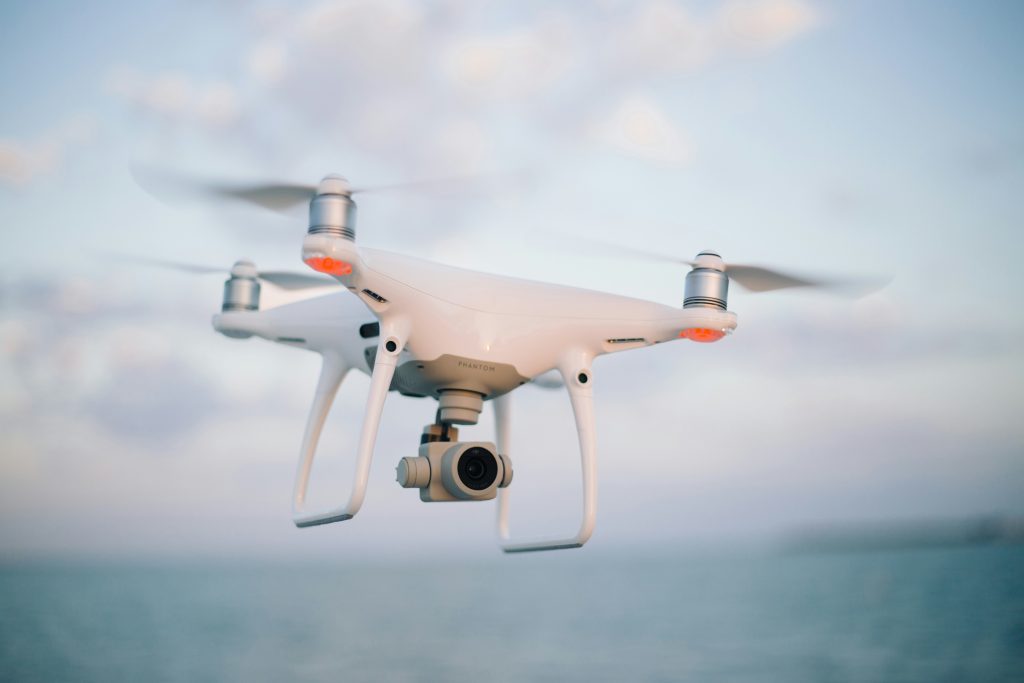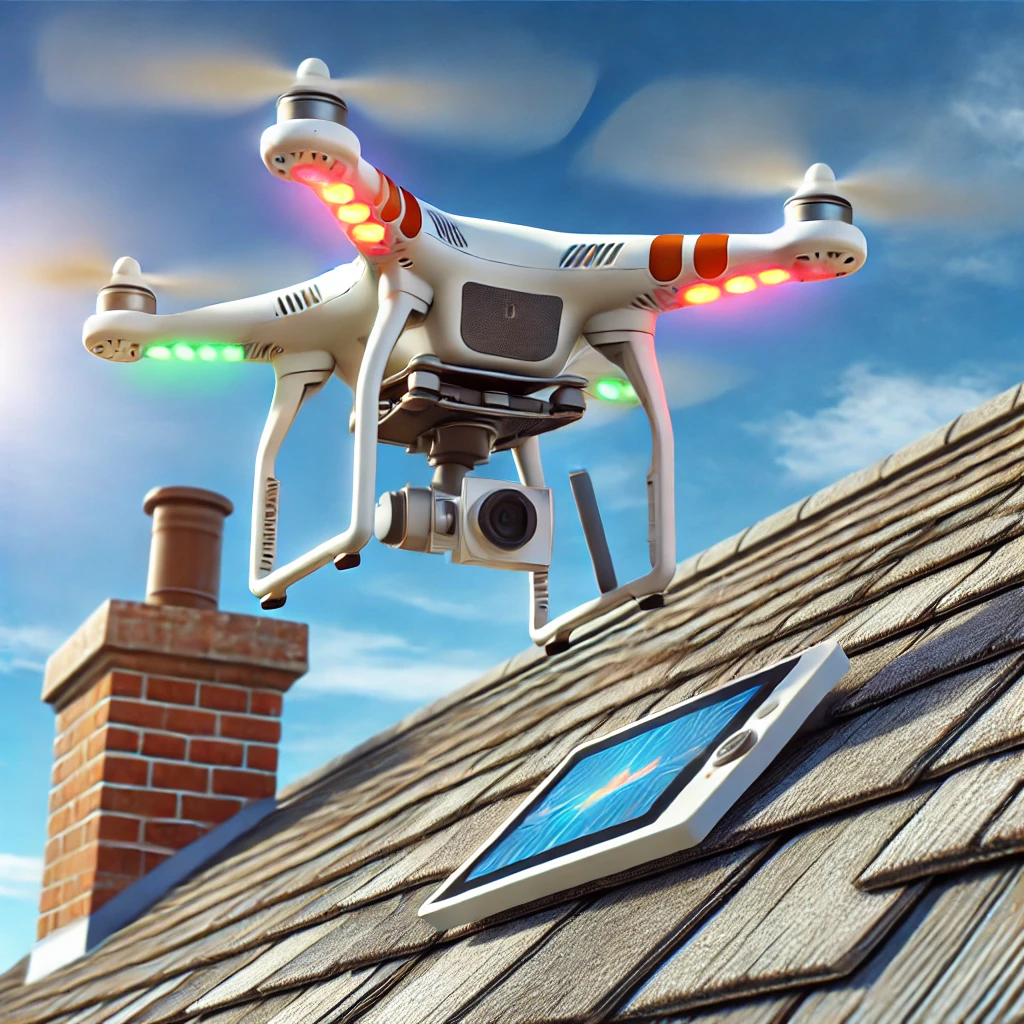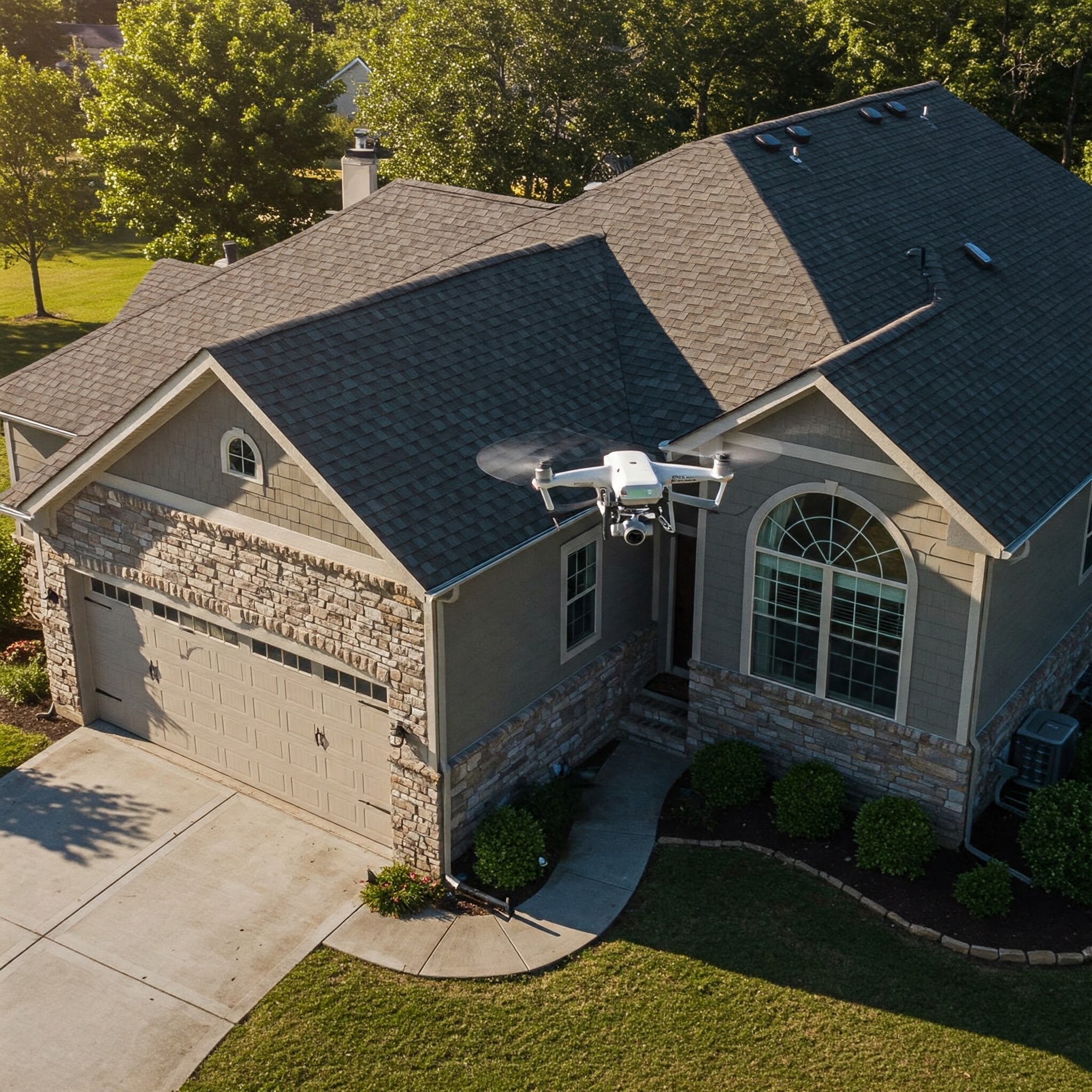Introduction
Drone technology is revolutionizing the roofing industry by enhancing safety, efficiency, and accuracy during roof inspections. From residential home assessments to large-scale commercial evaluations, drones offer a cost-effective alternative to traditional methods. This guide not only explains how drone roof inspections work but also highlights real-life success stories that showcase their transformative impact across various sectors. Whether you’re a roofing contractor, insurance adjuster, or a property manager, understanding the value of drone technology can help you make more informed decisions about how to approach roof inspections and maintenance.

What is a Drone Roof Inspection?
A drone roof inspection involves using an unmanned aerial vehicle (UAV) equipped with high-resolution cameras and thermal imaging sensors to assess roof conditions. These drones provide detailed imagery, identify damages, and generate comprehensive reports—all without requiring inspectors to physically access the roof. This reduces the need for dangerous ladder climbs, costly scaffolding, or the risk of missing crucial details from hard-to-reach areas.
How It Works: A Step-by-Step Guide
- Pre-Flight Planning: Ensure compliance with regulations, check weather conditions, and prepare the drone. This includes reviewing local airspace restrictions and ensuring the drone’s software is up-to-date.
- Drone Deployment: The drone is piloted or programmed to fly over the roof, capturing high-resolution images. Advanced drones are capable of flying autonomously, following pre-programmed flight paths and covering the entire roof surface systematically.
- Data Collection: The drone gathers visual and thermal data, detecting potential issues such as leaks, cracks, and wear-and-tear on roofing materials. Some drones can also collect data related to structural integrity, which is especially useful for large commercial properties.
- Analysis & Reporting: AI-powered software analyzes the collected data to identify roofing issues, generate heat maps, and even predict potential future problems. Detailed reports are created for further action, including actionable recommendations for repairs and maintenance.
The Advantages of Drone Roof Inspections
Drone technology is revolutionizing the roofing industry by enhancing safety, efficiency, and accuracy during roof inspections. Utilizing unmanned aerial vehicles (UAVs) equipped with high-resolution cameras and sensors, drone roof inspections offer several benefits over traditional methods:
Enhanced Safety: By eliminating the need for inspectors to physically climb onto roofs, drones significantly reduce the risk of accidents and injuries.
Time Efficiency: Drones can swiftly survey extensive roof areas, completing inspections in a fraction of the time required for manual assessments.
Comprehensive Data Collection: Equipped with advanced imaging technology, drones capture detailed visuals and thermal data, enabling the detection of issues that might be overlooked during conventional inspections.
Access to Hard-to-Reach Areas: Drones can easily navigate and inspect areas that are difficult or dangerous for human inspectors to access, ensuring no part of the roof is left unchecked.
For a more in-depth exploration of how drone roof inspections enhance accuracy and provide additional benefits, consider reading our detailed article on The Benefits of a Drone Roof Inspection for Accuracy.
Industries Using Drone Roof Inspections
- Insurance: Insurance companies use drones to assess storm damage, process claims faster, and lower costs associated with traditional inspections. Drone inspections are often performed after natural disasters to quickly evaluate the extent of roof damage and estimate repair costs.
- Real Estate: Drones provide roof condition reports for buyers, sellers, and property managers. This improves transparency during the sale or lease process and aids in decision-making regarding property maintenance and repairs.
- Solar Energy: Drones are particularly valuable for evaluating roofs before solar panel installations. They help assess the roof’s structural integrity, the potential for shading, and any damage that may affect panel placement.
- Construction: Contractors use drones for pre-construction assessments, progress tracking, and ongoing maintenance. Drones also assist in the inspection of buildings under construction to ensure all work is done according to specifications and code.
- Municipalities and Government Agencies: Drones are increasingly used by local governments to monitor the condition of public buildings, infrastructure, and roads, providing cost-effective and comprehensive assessments for public safety and regulatory compliance.
Real-Life Success Stories: The Power of Drones in Action
Chesterfield County’s Fire Department Roof Assessment
- Challenge: The synthetic slate roof of a county fire station required a comprehensive inspection due to minimal maintenance.
- Solution: Roof Consulting Services used a DJI Inspire 2 drone to capture 268 high-resolution images, revealing seven deficiencies across 36 locations.
- Outcome: The issues were addressed with an estimated $4,000 in repairs, ensuring the roof’s integrity for at least another decade. The detailed imagery also helped the county avoid more expensive repairs in the future.
Geoff Neal Roofing’s Enhanced Survey Process
- Challenge: Traditional inspection methods were slow, costly, and posed safety risks, prompting Geoff Neal Roofing to find a more efficient solution.
- Solution: Geoff Neal Roofing incorporated drones into their survey process, allowing for quicker and safer data collection.
- Outcome: The adoption of drones enabled faster, more efficient inspections. This not only reduced operational costs but also enhanced client satisfaction through more timely reporting and decision-making.
Claims Adjuster’s Efficient Damage Assessment
- Challenge: A homeowner in Maine reported water damage on a second-floor ceiling, requiring a roof inspection to determine the cause. The roof was steep and difficult to access manually.
- Solution: The insurance adjuster deployed an EagleView Assess™ drone to conduct the inspection. The drone quickly captured high-resolution photographs of the entire roof, including hard-to-reach areas.
- Outcome: The drone revealed multiple issues, including missing chimney flashing and blocked downspouts. Identifying these problems allowed for timely repairs and an expedited claims process.
Charles House Roof Inspection by Virtual Services Group
- Challenge: Charles House required a thorough roof inspection to identify water damage and prevent internal issues.
- Solution: Virtual Services Group used drones with high-resolution cameras and thermal imaging to conduct a detailed inspection.
- Outcome: The inspection uncovered significant concerns, such as water ingress and gutter blockages due to debris. The findings enabled the property management team to address the issues proactively.
Football Stadium Roof Inspection by TEXO
- Challenge: A football stadium roof needed an extensive inspection after water was discovered inside steel beams during routine maintenance.
- Solution: TEXO used a combination of drones, including the Elios 3 for internal inspections and the DJI M300 for external roof assessments.
- Outcome: The drone-based approach eliminated the need for risky work at heights and completed the inspection in just four days, significantly faster than traditional methods. The data helped prevent further water damage and structural issues.
Challenges and Solutions in Drone Roof Inspections
- Weather Conditions: Drones can be impacted by adverse weather such as high winds, rain, and low visibility. To combat this, schedule inspections for clear days and use drones with strong stabilization features for optimal performance.
- Battery Life Limitations: Most drones have a flight time of 20-40 minutes per battery. To maximize flight time, use power-efficient modes, carry additional batteries, and plan the inspection route strategically.
- Data Management: The large volumes of data captured by drones can be difficult to manage. Cloud-based storage solutions like DroneDeploy, Skydio, or EagleView can simplify data storage and facilitate AI-driven analysis for actionable insights.
The Future of Drone Roof Inspections
The future of drone roof inspections is bright, with ongoing advancements such as:
- AI-Powered Predictive Maintenance: Using machine learning algorithms, drones could not only detect damage but also predict when maintenance will be required, allowing for proactive action.
- Fully Autonomous Drones: The development of autonomous drones capable of performing inspections and analyzing data without human intervention will streamline roof inspections even further.
- Integration with IoT: Drones working alongside IoT devices and smart sensors can provide real-time roof monitoring and instant reporting on roof conditions.
Conclusion
Drone roof inspections have proven to be a game-changer for industries such as roofing, insurance, and real estate. By combining safety, efficiency, and accuracy, drones are transforming how roof inspections are conducted. The ability to quickly collect detailed imagery and generate comprehensive reports not only saves time and money but also provides valuable insights that drive better decision-making. With ongoing advancements in AI, automation, and integration with other technologies, the role of drones in roof inspections will continue to expand, offering even greater value to industries seeking cost-effective and reliable inspection solutions.
If you’re in the roofing, insurance, or construction industries, investing in drone technology could help you streamline operations, improve customer satisfaction, and stay ahead of the competition. Now is the time to embrace the future of roof inspections—are you ready to take your inspections to the next level with drones?
FAQ: Drone Roof Inspections
A drone roof inspection uses unmanned aerial vehicles (UAVs) equipped with high-resolution cameras and thermal sensors to capture images and videos of a roof's condition. This technology enables roofing professionals to assess roof damage, detect leaks, and generate comprehensive reports without physically accessing the roof, ensuring safety and efficiency.
Drone roof inspections are highly accurate, especially when equipped with high-quality cameras and thermal imaging sensors. Drones can capture detailed, high-resolution images that allow for precise evaluations of roof conditions, including identifying cracks, leaks, and potential weak spots. The data is analyzed using AI-powered software, which ensures more accurate results and reduces human error.
Yes, drone roof inspections are generally safer than traditional roof inspections. Drones eliminate the need for human inspectors to climb ladders or walk on potentially dangerous roofs, reducing the risk of falls and accidents. Drones can also reach areas that would otherwise be difficult or unsafe for a person to access, improving safety for both inspectors and property owners.
The cost of a drone roof inspection varies depending on factors like the size and complexity of the roof, the region, and the service provider. On average, a drone roof inspection can range from $100 to $1,000 or more. However, this cost is typically lower than traditional inspections, especially when factoring in the time and equipment needed for manual assessments.
Drone roof inspections are significantly faster than traditional methods. On average, a drone can complete an inspection of a typical residential roof in 15-30 minutes. Larger commercial roofs may take longer, but the overall time is still considerably shorter compared to manual inspections, which can take hours or even days.
Yes, drones equipped with thermal imaging sensors can detect hidden roof damage, such as leaks, trapped moisture, and areas of heat loss. Thermal imaging helps identify problems that may not be visible to the naked eye, such as insulation issues, water infiltration, or underlying structural damage.
Drones are versatile and can be used for most types of roofs, including asphalt shingles, metal, tile, and flat roofs. However, certain roof conditions, such as very steep pitches or roofs with significant obstructions, may require additional planning or specialized equipment to ensure a safe and effective inspection.
While drones provide a more efficient and accurate method for inspecting roofs, they may not completely replace traditional inspections in all cases. For example, some situations may require a physical inspection to assess internal structural issues, inspect roofing materials up close, or verify the drone’s findings. However, drones can be used for the majority of inspections, especially when it comes to safety, speed, and cost-effectiveness.
Drone roof inspections typically generate detailed reports that include high-resolution images, videos, and thermal data. These reports can highlight areas of concern, such as cracks, missing shingles, and leaks, and provide recommendations for repairs or maintenance. Advanced software may also offer predictive insights into future roof issues based on the data collected.
Yes, drone roof inspections are generally more cost-effective than traditional methods. They reduce the need for scaffolding, ladders, or extensive labor costs, and they take less time to complete. This makes them a particularly attractive option for both homeowners and businesses looking to save money while ensuring thorough roof evaluations.
Yes, drone operators should be licensed and comply with local regulations. In many regions, commercial drone pilots are required to have certification from aviation authorities (such as the FAA in the U.S.). This ensures that the inspection is conducted safely and legally, with respect for airspace restrictions and other safety guidelines.
Drone roof inspections speed up the process of assessing roof damage for insurance claims. The high-resolution images and thermal data captured by drones provide insurers with accurate and detailed evidence of damage, allowing for faster claims processing and more accurate repair estimates. This reduces the time and cost involved in the claims process and helps policyholders receive fair settlements more quickly.
Yes, drones can be used for ongoing roof monitoring, especially when paired with IoT devices and sensors. Regular drone inspections can help property managers or building owners monitor the roof’s condition over time, allowing for proactive maintenance and early identification of potential problems before they require costly repairs.
Drone roof inspections are more environmentally friendly than traditional methods. They require fewer physical resources, such as scaffolding or trucks, and generate less waste. Additionally, drones can be used to conduct inspections without causing damage to the environment, making them a more sustainable option for roofing assessments.
Absolutely! Drones are especially valuable for inspecting commercial roofs, which are often larger, more complex, and harder to access. They allow for quicker, safer, and more detailed assessments of commercial properties, reducing downtime and the need for disruptive, costly inspections.

